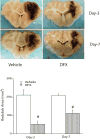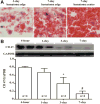Injury mechanisms in acute intracerebral hemorrhage
- PMID: 28947377
- PMCID: PMC6027647
- DOI: 10.1016/j.neuropharm.2017.09.033
Injury mechanisms in acute intracerebral hemorrhage
Abstract
Intracerebral hemorrhage (ICH) is the most common hemorrhagic stroke subtype, and rates are increasing with an aging population. Despite an increase in research and trials of therapies for ICH, mortality remains high and no interventional therapy has been demonstrated to improve outcomes. We review known mechanisms of injury, recent clinical trial results, and newly discovered signaling pathways involved in hematoma clearance. Enthusiasm remains high for methods of minimally invasive clot removal as well as pharmacologic strategies to improve recovery after ICH, both of which are currently being evaluated in clinical trials. This article is part of the Special Issue entitled 'Cerebral Ischemia'.
Keywords: Brain edema; Hematoma; Hypertension; Intracerebral hemorrhage; Iron; Thrombin.
Copyright © 2017 Elsevier Ltd. All rights reserved.
Figures




References
-
- Alam J, Stewart D, Touchard C, Boinapally S, Choi AM, Cook JL. Nrf2, a Cap“n”Collar transcription factor, regulates induction of the heme oxygenase-1 gene. J. Biol. Chem. 1999;274:26071–26078. - PubMed
-
- Anderson CS, Heeley E, Huang Y, Wang J, Stapf C, Delcourt C, Lindley R, Robinson T, Lavados P, Neal B, Hata J, Arima H, Parsons M, Li Y, Wang J, Heritier S, Li Q, Woodward M, Simes RJ, Davis SM, Chalmers J INTERACT2 Investigators. Rapid blood-pressure lowering in patients with acute intracerebral hemorrhage. N. Engl. J. Med. 2013;368:2355–2365. doi: 10.1056/NEJMoa1214609. - DOI - PubMed
-
- Baharoglu MI, Cordonnier C, Al-Shahi Salman R, de Gans K, Koopman MM, Brand A, Majoie CB, Beenen LF, Marquering HA, Vermeulen M, Nederkoorn PJ, de Haan RJ, Roos YB PATCH Investigators. Platelet transfusion versus standard care after acute stroke due to spontaneous cerebral haemorrhage associated with antiplatelet therapy (PATCH): a randomised, open-label, phase 3 trial. Lancet. 2016a;387:2605–2613. doi: 10.1016/S0140-6736(16)30392-0. - DOI - PubMed
-
- Baharoglu MI, Cordonnier C, Al-Shahi Salman R, de Gans K, Koopman MM, Brand A, Majoie CB, Beenen LF, Marquering HA, Vermeulen M, Nederkoorn PJ, de Haan RJ, Roos YB PATCH Investigators. Platelet transfusion versus standard care after acute stroke due to spontaneous cerebral haemorrhage associated with antiplatelet therapy (PATCH): a randomised, open-label, phase 3 trial. Lancet. 2016b;387:2605–2613. doi: 10.1016/S0140-6736(16)30392-0. - DOI - PubMed
Publication types
MeSH terms
Grants and funding
LinkOut - more resources
Full Text Sources
Other Literature Sources
Medical

